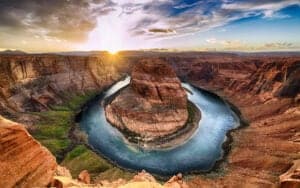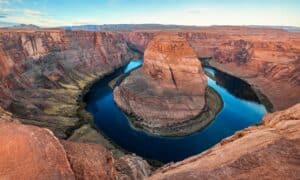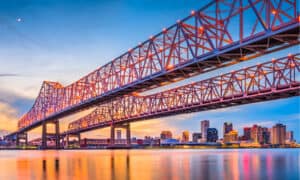What’s the longest bridge that crosses the Mississippi River?
It is known that 71% of the world is water, with oceans occupying 96.5%, while rivers, streams, ponds, and lakes occupy the remaining 3.5%. As a result, building bridges across different water bodies to connect two or more locations became necessary to reduce risks, increase livelihoods, and ease movement. Before we take you any further, let’s have a snippet of this great river, the Mississippi River.
The Mississippi River
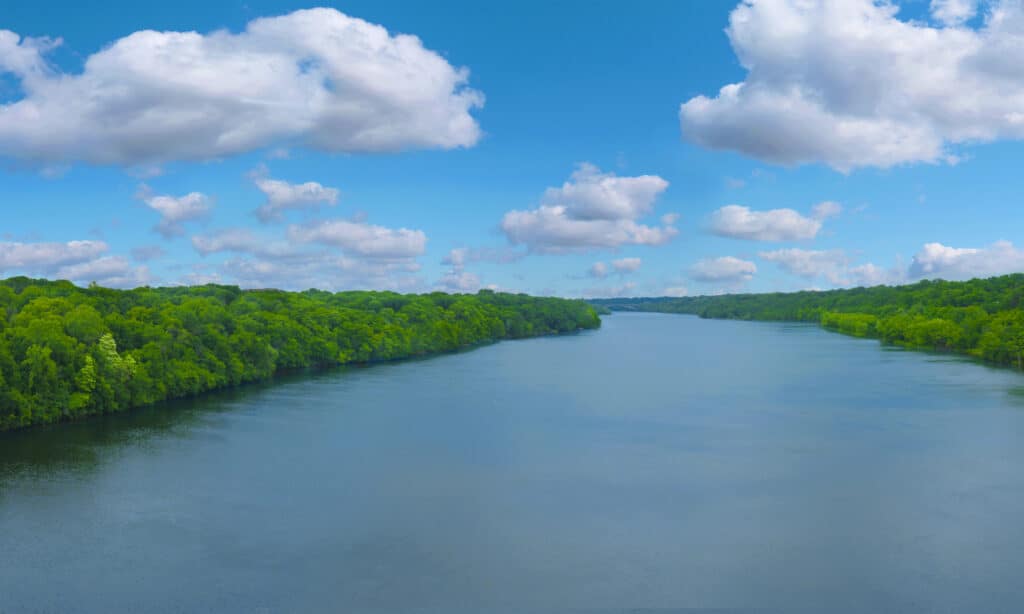
Milen Mkv/Shutterstock.com
The Mississippi River isn’t the only river in the United States with tough stretches, and for a fact, it isn’t the largest river in the U.S. The Mississippi River, having over 2,300 miles in length, remains the second-longest river system in the continental United States, flowing from Minnesota to the Gulf of Mexico. It is the second-longest river in North America as it makes its way through 10 different U.S. states, including Arkansas, Mississippi, Louisiana, Missouri, Tennessee, Kentucky, Illinois, Wisconsin, Iowa, and Minnesota. Interestingly, this river flows through 20% of the United States, starting in Lake Itasca, Minnesota, and ending in the Gulf of Mexico.
For its extended length, it was needful to construct a long-lasting bridge over the river, leading to the construction of the first bridge (Eads), which began in 1867 and ended in 1874. But over time, more sophisticated bridges were constructed due to river traffic, collisions, and other factors.
What’s the longest bridge that crosses the Mississippi River?

iStock.com/TreyCambern
The Greenville Bridge is the longest and last bridge to cross the Mississippi River in Arkansas, connecting Refuge, Mississippi, and Shives, Arkansas. This bridge is the most uniquely designed compared to other Mississippi River bridges. It is a supercool cable-stayed bridge, having large towers from which cables hang to support the major portion of the bridge. Its construction was completed in 2010, leading to the dismantling of the older bridge. Since then, the Greenville Bridge has served as the crossing point for US 82.
How the construction started
From its inception till completion, the construction of the Greenville bridge running across the stretchy Mississippi River was a record-setting project for the Department of Transportation, Mississippi. Growing needs birthed the emergence of the bridge’s construction on an idea to replace Benjamin G. Humphrey’s Bridge, which Massman Construction Co. also built in 1940. The Benjamin G. Humphreys Bridge became a hazard to river traffic due to its placement near a bend in the river.
The structure of the Greenville Bridge
The bridge’s substructural edifice consists of two major river piers founded on dredged caissons that extend 120 ft below the river bottom while supporting the main towers protruding as high as 425 feet above the river. The total pier height, by implication, is over 600 feet. During the construction, the normal depth of water as recorded was between 60 and 80 feet, while the end piers (two) each rested on 15 drilled shafts of over 6-feet in diameter. At the end of the construction, the bridge had the longest span on the lower Mississippi River, becoming one of the longest cable-stayed bridges in the U.S., with a main span of about 1,378 ft.
The bridge’s 90-foot wide roadway was constructed in 50-foot segments, each consisting of a structural steel frame assembly weighing about 80 tons. They are supported by a pair of cables anchored in the pier tower, six precast concrete slabs (each weighing 50 tons), and a concrete drive surface overlay. For its superstructure, the bridge has a roadway deck of about 2,970-feet long, containing two traffic lanes of about 12-foot wide, an 8-foot wide inside shoulder, and a 12-feet wide outside shoulder in each direction.
The construction of the Greenville Bridge
This bridge’s construction employed highly specialized methods to build the caissons for the two major river piers. The two piers were strongly built using a top-down construction technique and a floating caisson structure. Because of this method, the need arose to build a major breakwater, which utilized a 60-inch diameter steel piling and a V-shaped sheet pile structure to allow for a tolerable work environment amidst the fast current. This swift current had unobstructed river velocities, which ranged from 4 to 11 feet per second. As a result, Massman needed to develop a caisson guide system that could hold the floating concrete pier in place while the sinking operations were ongoing. Massman also developed a pneumatic buoyancy support system that kept the caissons afloat while they continually built up the wall sections on top of the caissons.
After all was said and done, a challenging situation needed to be addressed: the changed river hydraulics created a scour around the new piers. For this reason, Massman contracted with the United States Army Corps of Engineers to install an articulated concrete mattress on the river bottom to protect the two major piers. They also placed about 40,000 tons of riprap around the pier located on the riverbank.
What was the first bridge over the Mississippi?
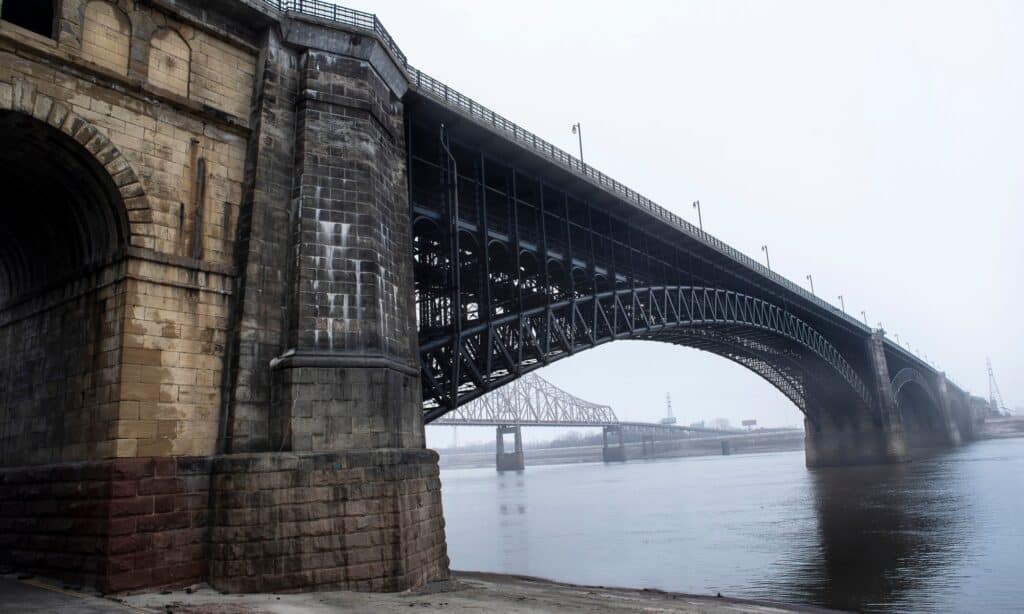
iStock.com/Jon Rehg
Eads Bridge, the first combined road and railway bridge over the Mississippi River, connected the cities of St. Louis, Missouri, and East St. Louis, Illinois. It was named after its designer and builder, James Buchanan Eads. The bridge’s construction began in 1867 and ended in 1874. It was the first bridge across the Mississippi south of the Missouri River. Other bridges before this were located north of the Missouri, where the Mississippi is smaller. Unfortunately, none survived, making Eads Bridge the oldest bridge on the river.
How did early settlers cross the Mississippi River?
One would wonder how early men got across this river because of its extended length. Well, canoes, the earliest ferries, were one of the earliest means by which people crossed the Mississippi River. Even before the whites penetrated as far west as the Mississippi, canoes served the Indians as a means of crossing the great river.
The earliest post-colonial commercial ferries started operating in the 1810s between Algiers Point and the French Quarter area. However, long before colonization, native Americans had rowed across the river for more than a century, harnessing steam power to cross the river for more than a century swiftly.
When these early settlers sighted a river afar off, they would send out scouts to check out the most suitable place to cross. They preferred to cross somewhere safe because too-deep or fast-moving waters would be dangerous for their animals, especially in areas where the rivers had undertow (chutes).
More from A-Z Animals
It is known that 71% of the world is water, with oceans occupying 96.5%, while rivers, streams, ponds, and lakes occupy the remaining 3.5%. As a result, building bridges across different water bodies to connect two or more locations became necessary to reduce risks, increase livelihoods, and ease movement. Before we take you any further, let’s have a snippet of this great river, the Mississippi River.
The Mississippi River

Milen Mkv/Shutterstock.com
The Mississippi River isn’t the only river in the United States with tough stretches, and for a fact, it isn’t the largest river in the U.S. The Mississippi River, having over 2,300 miles in length, remains the second-longest river system in the continental United States, flowing from Minnesota to the Gulf of Mexico. It is the second-longest river in North America as it makes its way through 10 different U.S. states, including Arkansas, Mississippi, Louisiana, Missouri, Tennessee, Kentucky, Illinois, Wisconsin, Iowa, and Minnesota. Interestingly, this river flows through 20% of the United States, starting in Lake Itasca, Minnesota, and ending in the Gulf of Mexico.
For its extended length, it was needful to construct a long-lasting bridge over the river, leading to the construction of the first bridge (Eads), which began in 1867 and ended in 1874. But over time, more sophisticated bridges were constructed due to river traffic, collisions, and other factors.
What’s the longest bridge that crosses the Mississippi River?

iStock.com/TreyCambern
The Greenville Bridge is the longest and last bridge to cross the Mississippi River in Arkansas, connecting Refuge, Mississippi, and Shives, Arkansas. This bridge is the most uniquely designed compared to other Mississippi River bridges. It is a supercool cable-stayed bridge, having large towers from which cables hang to support the major portion of the bridge. Its construction was completed in 2010, leading to the dismantling of the older bridge. Since then, the Greenville Bridge has served as the crossing point for US 82.
How the construction started
From its inception till completion, the construction of the Greenville bridge running across the stretchy Mississippi River was a record-setting project for the Department of Transportation, Mississippi. Growing needs birthed the emergence of the bridge’s construction on an idea to replace Benjamin G. Humphrey’s Bridge, which Massman Construction Co. also built in 1940. The Benjamin G. Humphreys Bridge became a hazard to river traffic due to its placement near a bend in the river.
The structure of the Greenville Bridge
The bridge’s substructural edifice consists of two major river piers founded on dredged caissons that extend 120 ft below the river bottom while supporting the main towers protruding as high as 425 feet above the river. The total pier height, by implication, is over 600 feet. During the construction, the normal depth of water as recorded was between 60 and 80 feet, while the end piers (two) each rested on 15 drilled shafts of over 6-feet in diameter. At the end of the construction, the bridge had the longest span on the lower Mississippi River, becoming one of the longest cable-stayed bridges in the U.S., with a main span of about 1,378 ft.
The bridge’s 90-foot wide roadway was constructed in 50-foot segments, each consisting of a structural steel frame assembly weighing about 80 tons. They are supported by a pair of cables anchored in the pier tower, six precast concrete slabs (each weighing 50 tons), and a concrete drive surface overlay. For its superstructure, the bridge has a roadway deck of about 2,970-feet long, containing two traffic lanes of about 12-foot wide, an 8-foot wide inside shoulder, and a 12-feet wide outside shoulder in each direction.
The construction of the Greenville Bridge
This bridge’s construction employed highly specialized methods to build the caissons for the two major river piers. The two piers were strongly built using a top-down construction technique and a floating caisson structure. Because of this method, the need arose to build a major breakwater, which utilized a 60-inch diameter steel piling and a V-shaped sheet pile structure to allow for a tolerable work environment amidst the fast current. This swift current had unobstructed river velocities, which ranged from 4 to 11 feet per second. As a result, Massman needed to develop a caisson guide system that could hold the floating concrete pier in place while the sinking operations were ongoing. Massman also developed a pneumatic buoyancy support system that kept the caissons afloat while they continually built up the wall sections on top of the caissons.
After all was said and done, a challenging situation needed to be addressed: the changed river hydraulics created a scour around the new piers. For this reason, Massman contracted with the United States Army Corps of Engineers to install an articulated concrete mattress on the river bottom to protect the two major piers. They also placed about 40,000 tons of riprap around the pier located on the riverbank.
What was the first bridge over the Mississippi?

iStock.com/Jon Rehg
Eads Bridge, the first combined road and railway bridge over the Mississippi River, connected the cities of St. Louis, Missouri, and East St. Louis, Illinois. It was named after its designer and builder, James Buchanan Eads. The bridge’s construction began in 1867 and ended in 1874. It was the first bridge across the Mississippi south of the Missouri River. Other bridges before this were located north of the Missouri, where the Mississippi is smaller. Unfortunately, none survived, making Eads Bridge the oldest bridge on the river.
How did early settlers cross the Mississippi River?
One would wonder how early men got across this river because of its extended length. Well, canoes, the earliest ferries, were one of the earliest means by which people crossed the Mississippi River. Even before the whites penetrated as far west as the Mississippi, canoes served the Indians as a means of crossing the great river.
The earliest post-colonial commercial ferries started operating in the 1810s between Algiers Point and the French Quarter area. However, long before colonization, native Americans had rowed across the river for more than a century, harnessing steam power to cross the river for more than a century swiftly.
When these early settlers sighted a river afar off, they would send out scouts to check out the most suitable place to cross. They preferred to cross somewhere safe because too-deep or fast-moving waters would be dangerous for their animals, especially in areas where the rivers had undertow (chutes).

